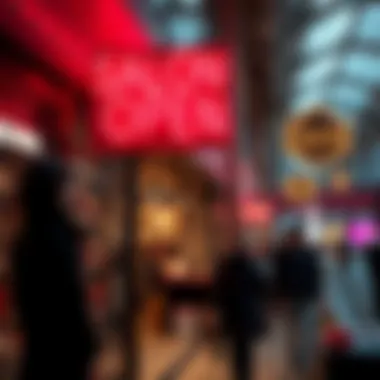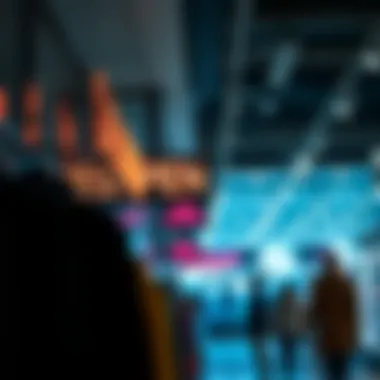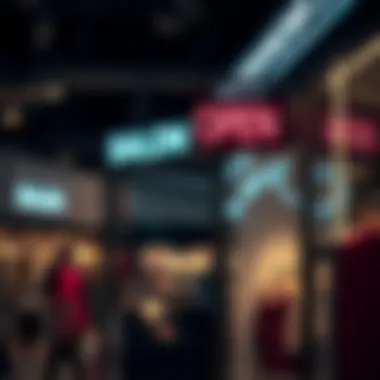Exploring the Impact of Salon Open Signs in Fashion


Intro
In the bustling world of fashion retail, where style and visibility go hand-in-hand, the open sign holds a surprisingly pivotal role. Not just a mere indicator of operational hours, these signs encapsulate the very essence of brand identity and ambiance. Imagine walking down a street jam-packed with boutiques, each clamoring for your attention. What’s the first thing that draws you in? Often, it’s the inviting glow of an open sign, signaling that inside, creativity and curated elegance await.
As salon owners craft unique identities for their spaces, open signs become an extension of this vision. They are not just signage; they transform into a silent yet engaging conversation with potential customers. Effective open signs do more than state a business is accessible; they tell a story, reflect trends, and instill trust.
This article takes a magnifying glass to the role of salon open signs in today’s competitive fashion landscape. We will explore how design choices influence consumer behavior, discuss innovative styles emerging in open signage, and ultimately highlight their importance in capturing customer eyes amidst a sea of choices.
Latest Trends in Open Sign Styles
Many salons today are leaning heavily into bold, eye-catching designs that resonate with contemporary aesthetics. The evolution of the open sign isn't just about functionality—it's also about how it contributes to the overall vibe of the shop. Here are some of the latest trends in salon open signage:
- Neon Glow: Neon signs create an impression of vibrancy. Their retro appeal combined with modern designs can attract passersby instantly.
- Eco-Friendly Materials: The use of sustainable materials is gaining traction. Signs made from reclaimed wood or recycled plastics not only look unique but also tell a story of responsibility.
- Digital Displays: The rise of technology brings digital signs that can be updated easily, showcasing ongoing promotions or new trends instantly.
- Artistic Touch: Hand-painted signs by local artists convey authenticity and creativity, instantly setting a salon apart from chain competitors.
"The right open sign is an extension of the salon's brand—where eye-catching design meets function."
Seasonal Must-Haves
With the changing seasons, the demand for specific styles will naturally shift. Open signs that reflect these transitions can also signal to potential customers what to expect inside. For instance,
- Spring: Bright colors and floral patterns can evoke freshness, offering bright visual cues that spring styles are on offer.
- Summer: Light hues with images of holiday escapades entice customers seeking carefree, seasonal looks.
- Autumn: Warm tones and rustic designs underline cozy, fall fashion must-haves.
- Winter: Weather-appropriate imagery, perhaps snowflakes or holiday motifs, can guide customers to special winter collections.
Impact on Consumer Behavior
Understanding how salon open signs influence consumer behavior is crucial. In an environment saturated with choices, the design and messaging of an open sign can play a decisive role in attracting customers.
An effective open sign does the following:
- Creates First Impressions: A well-designed sign tells a visitor instantly what to expect. A sleek, modern design can imply luxury, while a charming, artisanal look can suggest a personalized experience.
- Encourages Spontaneous Visits: A sign that catches eyes and evokes curiosity will likely convert passersby into immediate customers. Even those who hadn't intended to shop may wander in due to an enticing display.
- Establishes Trustworthiness: If a brand manages to present itself professionally through its signage, customers may inherently trust it more. This sense of trust can encourage them to make larger purchases.
The Future of Open Signage in Fashion Retail
As we march towards a more digital age in retail, the role of open signs will inevitably evolve. Side-by-side with traditional signage, augmented reality and holographic displays might soon join the fray, allowing salons to engage potential customers in unprecedented ways. Yet, amid all the advancements, the core purpose remains unchanged: to welcome patrons and elevate the shopping experience.
The discussion on salon open signs reminds us that even in fashion, the simplest elements can hold immense influence. To thrive amid competition, salon owners must pay attention to the often-overlooked details—the signs that invite customers to explore the qualities that lie within.
Prelims to Salon Open Signs
The realm of fashion retail has undergone a transformation over the years, and among the subtle yet powerful tools that aid in this evolution is the salon open sign. These signs are far from mere decorations; they serve a pivotal role in attracting potential customers and informing them of the business's operational status. In a landscape where competition is as thick as thieves, having a well-designed, strategically placed open sign can make or break a salon's chance to capture consumer interest.
Definition and Purpose
At its core, a salon open sign is a visual cue indicating that a business is ready for customers. Its primary purpose extends beyond that simple declaration; it encompasses several subtle layers of meaning. For instance, it not only confirms that services are available but also curates an image of accessibility and hospitality. This visual prompt can draw in pedestrians who might not have planned to visit but are swayed by the welcoming nature of the display.
When evaluating the effectiveness of open signs, it is essential to consider their placement and design. A bright neon sign can beckon people from afar, whereas a more muted, elegant design may cater to a different clientele who appreciate a more sophisticated allure. In other words, the definition of an open sign transcends its straightforward purpose – it becomes a brand ambassador, communicating a salon's identity and ethos at a glance.
Historical Context
The origins of open signs trace back to traditional storefronts, where the simplicity of communicating availability was paramount. Early examples included basic boards hanging from windows, often painted with rudimentary letters and symbols. As society progressed, so did the approach to these signs, innovating with styles and materials reflective of the broader marketing trends of the time.
In the 20th century, neon signs exploded in popularity, particularly in urban settings. The vibrant colors and glowing tubes designed by craftsmen captured attention, leading salon owners to adopt these eye-catching displays. This shift wasn’t just about being noticed; it represented a shift in consumer behavior, as shoppers began to research and select establishments based on visibility and perceived quality.
Today, the integration of technology has led to the rise of digital displays, moving away from static signs and embracing dynamic imagery and messaging. The evolution of salon open signs encapsulates a broader narrative about consumer behavior, accessibility, and branding. In an age where first impressions are crucial, these signs are instrumental in defining a salon's presence in a busy market, firmly establishing their importance in modern fashion retail.
The Impact of Open Signs on Salon Visibility
The importance of salon open signs cannot be understated. These signs play a crucial role in determining how visible a salon is to potential customers. Given that many retail businesses, including salons, compete for foot traffic, having an eye-catching and clear open sign can make all the difference in attracting clients. In the modern fashion retail landscape, where first impressions matter immensely, the visibility created by these signs taps into consumer behavior and decision-making processes in profound ways.
Consumer Perception
The first point to consider about consumer perception revolves around immediate recognition. When a potential customer passes by a salon, their gaze often flits toward any signage present, seeking cues for what type of services are offered. If a salon’s open sign is visually appealing and strategically placed, it can evoke curiosity and interest, prompting potential customers to walk through the door.
- Visibility Equals Credibility: Research shows that consumers associate brightly colored and well-lit signs with professionalism and reliability. A shabby or poorly designed sign might lead consumers to question the quality of services offered inside,
- Psychological Triggers: Additionally, the psychology behind colors plays a significant role; for instance, a vibrant red can invoke feelings of urgency or excitement.
"The signs you display not only tell if you're open but also reflect your brand's identity and professionalism."


Understanding how these nuances affect consumer perception allows salon owners to harness their signage for maximum impact. A salon that appears inviting at first glance can significantly increase the chances customers will enter.
Location and Signage Strategy
Location is perhaps one of the most critical factors in retail success. For salons, choosing a spot with high foot traffic can make a substantial difference in visibility. According to statistical data, businesses located near popular shopping areas or community centers tend to capture a larger customer base.
Moreover, integrating an effective signage strategy tailored to the location can greatly increase a salon’s profile:
- Height and Placement: A sign placed at eye level, particularly at pedestrian height, is far more likely to catch attention than one situated higher up. Ensuring the sign is visible from both sides of the street can maximize exposure.
- Complimentary Design: The design of the sign should not only align with the salon's brand identity but also harmonize with the surroundings. For example, in a trendy urban area, a chic minimalist sign might resonate better than a flamboyant one.
- Regulatory Compliance: Salons must also consider zoning laws that govern signage in their area. Some locations have restrictions that dictate the size, lighting, and even color of signs. Being aware of these regulations ensures that the salon does not face unnecessary fines or removal.
Combining an intelligent location choice with a differentiated signage strategy enhances visibility and entices potential clients to enter, making it a vital aspect of modern salon retail.
Design Elements of Effective Open Signs
Creating distinctive and attractive open signs is no small feat. It calls for a deep understanding of various design elements that work in concert to draw in potential customers. These elements play a pivotal role in how effectively a salon can communicate its presence and values to foot traffic. Several factors come into play: colors, fonts, and materials. Each choice reflects the salon's branding and can influence consumer perception, making thoughtful design an essential strategy in modern fashion retail. Let's break each component down to explore their significance.
Color Psychology
Color isn’t just pretty; it’s powerful. The hues chosen for an open sign can evoke specific feelings and attitudes, impacting consumer behavior directly. For instance:
- Red: Often associated with passion and energy, it can create a sense of urgency.
- Blue: Known for its calming effects, this shade can instill trust and reliability, which is vital for service-oriented businesses like salons.
- Green: Signifying nature and renewal, green shades can portray eco-friendliness and relaxation.
When designing an open sign, it’s vital to consider the emotional resonance of colors. A well-thought-out color palette not only grabs attention but can also align with the salon's brand identity. For example, a trendy salon might opt for bright yellow or fluorescent pink, which pop and suggest vibrancy and fun, while a spa might lean toward softer tones like beige or pastels that convey tranquility.
"Color is a power which directly influences the soul." – Wassily Kandinsky
Font Choices and Readability
The font used on an open sign should do more than just look neat; it needs to be legible from a distance while capturing the character of the business. This is where choosing the right font style comes into play. Here are points to consider:
- Clarity: Bold, sans-serif fonts are often recommended because they are easier to read, especially from afar.
- Style: While cursive fonts might convey elegance, they can also sacrifice readability. Striking the right balance is critical.
- Size: Larger fonts ensure visibility and help convey messages quickly without making customers squint.
Keep the target audience in mind. A youthful salon may opt for contemporary, playful fonts, while a more classic establishment might go for traditional typefaces. The font choice must reflect the salon's ethos, letting passersby know they can expect a particular experience within the walls.
Material and Durability
Material selection is another crucial element of open sign design. The durability of materials influences not just aesthetics but also maintenance and weather resistance, which are important factors in many locations. Consider the following:
- Acrylic: Lightweight and able to take on various colors, acrylic signs are often used for their modern look and longevity.
- Wood: Offers an organic, sophisticated feel, great for high-end salons but may require more upkeep.
- Vinyl: Highly versatile and cost-effective, vinyl can be used for simple door hangers or as a large banner.
In choosing materials, salons must think about how their open sign will withstand elements like wind, rain, or sun exposure. A sign that fades or breaks can create a negative impression, counteracting the very effort put into making it attractive. Durable materials not only project professionalism but also ensure lasting visibility.
Integration of these design elements is not just about looking good on one day. With strategic choices, salon open signs can become a powerful marketing tool, influencing customer perceptions and decisions long after they are first seen.
Innovative Signage Trends in the Beauty Industry
The beauty industry undergoes constant evolution, influenced by not just fashion trends but also technological advancements and consumer preferences. Salon open signs, in this context, have become pivotal in attracting attention and establishing brand identity. Understanding innovative signage trends provides valuable insights into how salons can optimize visibility and create memorable experiences for customers.
Digital vs. Traditional Open Signs
The battle between digital and traditional open signs isn’t just a matter of aesthetics; it’s a strategic decision impacting how a salon communicates with potential clients. Digital signs often boast versatility, allowing salons to display not only the open status but also promotions, images, and interactive content. With LED technology, these signs can change messages at a moment's notice, ensuring that the information remains relevant and timely.
Meanwhile, traditional signs, crafted from wood or acrylic, often evoke a sense of authenticity and craftsmanship. They can complement the salon's decor style and create a cohesive visual identity. An eye-catching design can lure passersby, appealing to the nostalgia of simpler times. Despite the rise of technology, there remains a robust market for these classic options, especially among clientele who appreciate artisanal touch.
It’s important to consider the target demographic when choosing between these two options. For example, a modern, urban salon may benefit more from digital signage, while a small-town barbershop might find that a rustic wooden sign attracts more local customers.
"The right open sign isn't just a marker; it's a conversation starter, an ambassador of your brand's ethos."
Benefits of Each Type:
- Digital Signs:
- Traditional Signs:
- Versatility in message and design
- Attracts tech-savvy customers
- Capable of displaying multiple offers
- Craftsmanship resonates with local culture
- Timeless appeal creates a strong brand presence
- Potentially lower maintenance costs


Environmental Considerations
As the world grows ever more conscious of its environmental impact, salons are also shifting their signage strategies to align with sustainability practices. The use of eco-friendly materials for open signs can enhance a salon's brand image while meeting consumer demand for responsible business practices. For instance, signs made from reclaimed wood or recycled materials not only reduce waste but also tell a story that resonates with environmentally-conscious customers.
Furthermore, energy-efficient digital signs can also contribute towards a greener footprint. Utilizing solar panels to power these displays is an option some innovative salons are considering. This move not only cuts down on electricity costs but also places the salon as a leader in environmental stewardship, which can be particularly appealing to younger audiences.
In summary, as salons contemplate their signage strategy, incorporating environmental considerations can be a major selling point. Salons not only attract customers through visual appeal but also foster a connection rooted in shared values surrounding sustainability. This alignment becomes vital, especially as consumer preferences tilt more towards brands that reflect their ethical beliefs.
Epilogue of Trends
When examining innovative signage trends in the beauty industry, it becomes clear that a balance between digital and traditional elements is essential. Salons should weigh the benefits of technology against the timeless appeal of classic craftsmanship, all while keeping sustainability in focus. This dynamic approach ensures that open signs do not merely serve as markers, but as integral components of the salon's brand identity and customer experience.
For further exploration, resources such as Wikipedia, Britannica, and sustainability-focused sites like GreenBiz provide foundational insights into both traditional and innovative signage trends.
Legal and Regulatory Aspects of Salon Open Signs
Understanding the legal and regulatory aspects of salon open signs is crucial in this industry. Navigating through zoning laws and the permitting processes can be a bit of a minefield. However, being aware of these regulations not only keeps salons compliant but helps in maximizing their visibility and effectiveness as a marketing tool.
Zoning Laws and Signage Regulations
Zoning laws dictate how and where salons can display their open signs. These regulations, which vary widely from one municipality to another, are designed to maintain the aesthetic and functional harmony of neighborhoods. For instance, in some urban areas, certain colors or designs may be restricted to preserve the character of the streetscape. This means that a salon must not only consider the content of its signage but also its compliance with local ordinances.
Understanding these rules can be the difference between a successful launch and an expensive misstep. Some common regulations include:
- Size Limits: Many areas impose maximum dimensions for signs. A well-placed, appropriately sized sign can attract attention without being overwhelming.
- Lighting Restrictions: Certain regions may restrict the use of illuminated signs during specific hours to minimize light pollution.
- Design Guidelines: Some communities foster a unique architectural style; thus, signs must align with that aesthetic.
Knowing how to navigate these laws can help salon owners avoid hefty fines and ensure their signs work as effective advertising rather than unnecessary liabilities.
Permitting Processes
Once salon owners understand zoning laws, they must also navigate the permitting process associated with open signs. Obtaining the right permits can feel daunting, but it's essential for legal operation. Here are some key steps typically involved in the permitting process:
- Research: Salon owners should start by checking local government websites or contacting local authorities for specifics on sign regulations.
- Application Submission: An application for a sign permit often requires details such as proposed dimensions, materials, colors, and illumination.
- Review Process: Authorities usually review submissions for compliance with relevant laws. This can take anywhere from a few days to several weeks, depending on local workloads and regulations.
- Approval or Rejection: If the proposed design meets all the criteria, the permit is issued; if not, owners may have to revise their designs and resubmit.
- Installation Compliance Check: Some areas may conduct follow-up inspections to ensure the sign reflects the approved design.
Not obtaining the necessary permits could lead to the removal of the signage and fines, which not only impacts visibility but also finances.
In summary, understanding and complying with legal and regulatory aspects around salon open signs ensures that businesses aren't just visible, but also reputable. By aligning their signage strategies with local laws and securing the proper permits, salons can effectively market themselves while avoiding legal pitfalls.
The Economic Value of Salon Open Signs
Salon open signs aren't just decorative objects hanging in windows; they hold significant economic value that can drive customer traffic and, ultimately, sales. These signs serve as a beacon, drawing in potential clients and creating a welcoming environment that encourages people to step inside and discover what your salon has to offer. In an ever-competitive market, understanding this economic impact is crucial for salon owners looking to maximize their returns.
Cost-Benefit Analysis
When we consider the cost-benefit analysis of salon open signs, it’s clear these signs can yield measurable returns. On one hand, the initial investment in a quality sign — whether it’s a classic neon piece or a sleek digital display — can feel substantial. However, the benefits often outweigh these costs dramatically.
- Initial Investment:
- Increased Foot Traffic:
- Branding and Recognition:
- Marketing Tool:
- Signs can range widely in price, depending on size, materials, and technology. For instance, a high-quality, LED-lit sign can cost anywhere from $100 to over $1,000, depending on the complexity and design.
- An attractive sign can draw customers in, turning passersby into paying clients. Studies have shown that well-designed storefront signage can increase sales by up to 15%. A salon standing out with its open sign can boost its visibility in a crowded area significantly.
- A thoughtfully designed open sign contributes to brand identity. It reinforces the salon’s aesthetic, making it more recognizable. The long-term branding effect should be considered a financial benefit as well.
- In essence, the sign acts as a low-cost marketing tool. Unlike advertisements that require ongoing investment, a well-made open sign provides year-round exposure.
Return on Investment
Evaluating the return on investment (ROI) for salon open signs involves a closer look at their impact on overall revenue. It’s not merely about how much money you spend, but rather how effectively that outlay translates into profit.
- Revenue Increase:
- Client Loyalty:
- Competitive Advantage:
- Usage Tracking:
- A properly placed open sign can result in a tangible rise in monthly revenue. If a sign brings in just a few extra clients per week, consider the average service price multiplied across several months.


- A well-crafted open sign that communicates warmth and professionalism can foster a sense of loyalty among clients, encouraging repeat visits. Repeat business is often less costly than acquiring new customers, so it feeds into a healthier bottom line.
- In areas with multiple salons, an eye-catching open sign can be the differentiator. Attracting clientele that may otherwise pass by can lead to a sustainable advantage, leading to increased market share.
- Salons can monitor client growth and tracking metrics like foot traffic in relation to their signage efforts. This can help in assessing the sign's direct contribution to profitability.
As saloon owners evaluate their marketing strategies, incorporating the open sign's performance into financial assessments could yield valuable insights regarding their business operations. With the right placement and design, salon open signs prove they’re not just signs on the street, but rather significant players in the financial game.
Case Studies: Successful Salon Signage
In the vibrant world of fashion retail, the effectiveness of salon open signs cannot be overstated. They serve more than just a practical function; they create a visual language that communicates the brand's identity and values to potential customers. An analysis of successful salon signage provides insightful lessons that can offer a competitive edge in a bustling marketplace where first impressions truly matter.
Popular Salon Brands and Their Open Signs
Certain salon brands stand out not simply for their services but for how they smartly use open signs. For example, Great Clips employs bright, bold colors and clear messaging that stands out in urban settings, effectively grabbing a passerby’s attention. The use of an instantly recognizable logo that spells out "OPEN" in eye-catching letters reinforces their brand identity while also making it clear that they are ready to serve customers.
Another notable example is Aveda, which does not shy away from creativity. Their open signs often reflect the eco-friendly ethos of the brand, utilizing earthy tones and organic shapes, which resonate with their target audience. Such aesthetics align with their brand image while simultaneously conveying their welcoming nature to visitors.
- Key Elements to Consider in Designing Effective Open Signs:
- Brand Identity: Open signs should reflect who you are as a brand.
- Color Palette: Bright hues might appeal to a younger clientele, while muted tones may align more with an upscale audience.
- Material Use: Wood or recycled materials may suggest sustainability, adding value to the overall message.
Moreover, Supercuts employs unique rotating signs that capture attention from long distances. They provide clarity over their hours and special promotions, maximizing the potential customer reach. This type of innovative strategy illustrates how salons can use signage dynamically, representing a blend of tradition and modern marketing strategies.
Analysis of Effective Strategies
Dissecting the signs utilized by these successful brands reveals common strategies that can be applied across various salons. One crucial aspect is ensuring readability from a distance. Signs need to be legible even when viewed at a quick glance. Large fonts and minimal clutter serve to effectively communicate with potential clients passing by.
Additionally, integrating local context into signage can significantly enhance effectiveness. For example, using local dialects, slang, or symbols can make the sign relatable to the community, inviting local patronage. Also, reflective materials might catch the attention of customers during both day and night, increasing visibility.
The placement of open signs is another critical factor. A well-placed sign might be the difference between a potential client walking in or passing by. For instance, signs positioned near entrances or within sight of main thoroughfares can capture fleeting moments of attention.
Furthermore, evaluating the time of day and tailoring signage accordingly—such as illuminated signs at night—can lead to better engagement with the clientele.
Future Directions in Salon Signage
Understanding the future of salon signage is crucial for any business aiming to remain relevant in this evolving market. Salons no longer can rely solely on traditional methods to grab attention; instead, they must embrace innovative approaches that align with current consumer expectations and technological advancements. This section delves into two critical aspects shaping the future of salon signage: technological innovations and sustainability trends.
Technological Innovations
In today’s tech-savvy world, salons are beginning to harness the potential of various technological developments to enhance their signage strategies. Digital displays are becoming increasingly popular, offering dynamic content that can change in real-time. This ability to update information quickly can highlight special promotions, new services, or seasonal offers, providing flexibility that traditional signs simply cannot match.
Moreover, incorporating QR codes into salon open signs is another trend worth mentioning. Such codes can lead curious passersby to websites or social media pages, allowing salons to connect with a broader audience. Imagine someone walking by, curious about a service; a quick scan can provide details, reviews, or even booking capabilities right from their smartphones. This interactivity is a promising way to engage potential customers right where they stand, and it’s an effective tool in influencing consumer choices.
Furthermore, artificial intelligence (AI) is making its way into the signage scene. AI-driven solutions can analyze foot traffic and consumer behavior, allowing salons to tailor their messages effectively. Over time, by assessing data and consumer interactions, these systems can suggest optimal signage designs or layouts, maximizing the chances of drawing in customers.
Sustainability Trends
As awareness about environmental issues grows, salons are starting to reflect these values in their signage as well. Sustainability is no longer just a buzzword; it's becoming a crucial component of the branding for many businesses. The use of recycled materials in sign production is on the rise, allowing salons to convey a commitment to eco-friendliness. Being able to showcase such practices can enhance a salon's reputation among environmentally-conscious consumers.
Additionally, energy-efficient lighting is becoming a standard in salon signage. Switching to LED lights means not only reduced energy costs but also a longer lifespan for the signage. That's a win-win for the business and the planet, as it decreases waste and energy consumption.
Salons are also considering the life cycle of their signage, opting for designs that minimize environmental impact—from materials used to the disposal of old signs. This added layer of consideration showcases a brand's ethics and values, potentially attracting clients who prioritize sustainability.
The future of salon signage lies in intertwining technology and sustainability, giving businesses the tools they need to engage their audiences effectively while being mindful of environmental impact.
The End
In this article, we have traversed the multifaceted role that salon open signs play in the increasingly competitive realm of fashion retail. These signs are not merely visual markers— they serve as critical gateways through which customer foot traffic flows. The integration of well-designed open signs can significantly enhance salon visibility, drawing in passersby who might otherwise remain unaware of the services offered within. The strategic placement and thoughtful design of these signs are vital elements of a salon's marketing toolkit, influencing consumer perception and potentially altering customer behavior.
Recap of Key Points
To encapsulate the insights garnered throughout this discussion, here are the key takeaways:
- Visibility and Consumer Engagement: Open signs capture the attention of potential customers, acting as beacons that invite exploration.
- Design Elements: A combination of color psychology, font choices, and the material of the signs must align to convey the salon's brand message effectively.
- Legal and Economic Factors: Understanding zoning laws and conducting a cost-benefit analysis help ensure that the signage investment is worthwhile.
- Innovative Trends: As digital technology advances, there is an emerging trend towards using digital display signs that are capable of dynamic content, thus enhancing engagement even further.
- Future Directions: Sustainability is becoming a pivotal factor in signage production, pushing salons to seek eco-friendly materials and designs.
Final Thoughts on Signage Importance
"A good sign is worth a thousand words; it speaks without speaking." It’s a reminder to salons everywhere that the right signs are indeed indispensable in their journey through the vibrant and dynamic landscape of fashion retail.
For further reading and resources on signage in retail, consider visiting Wikipedia on Business Signage or check out industry insights on reddit.com.







